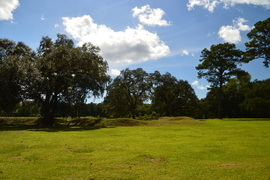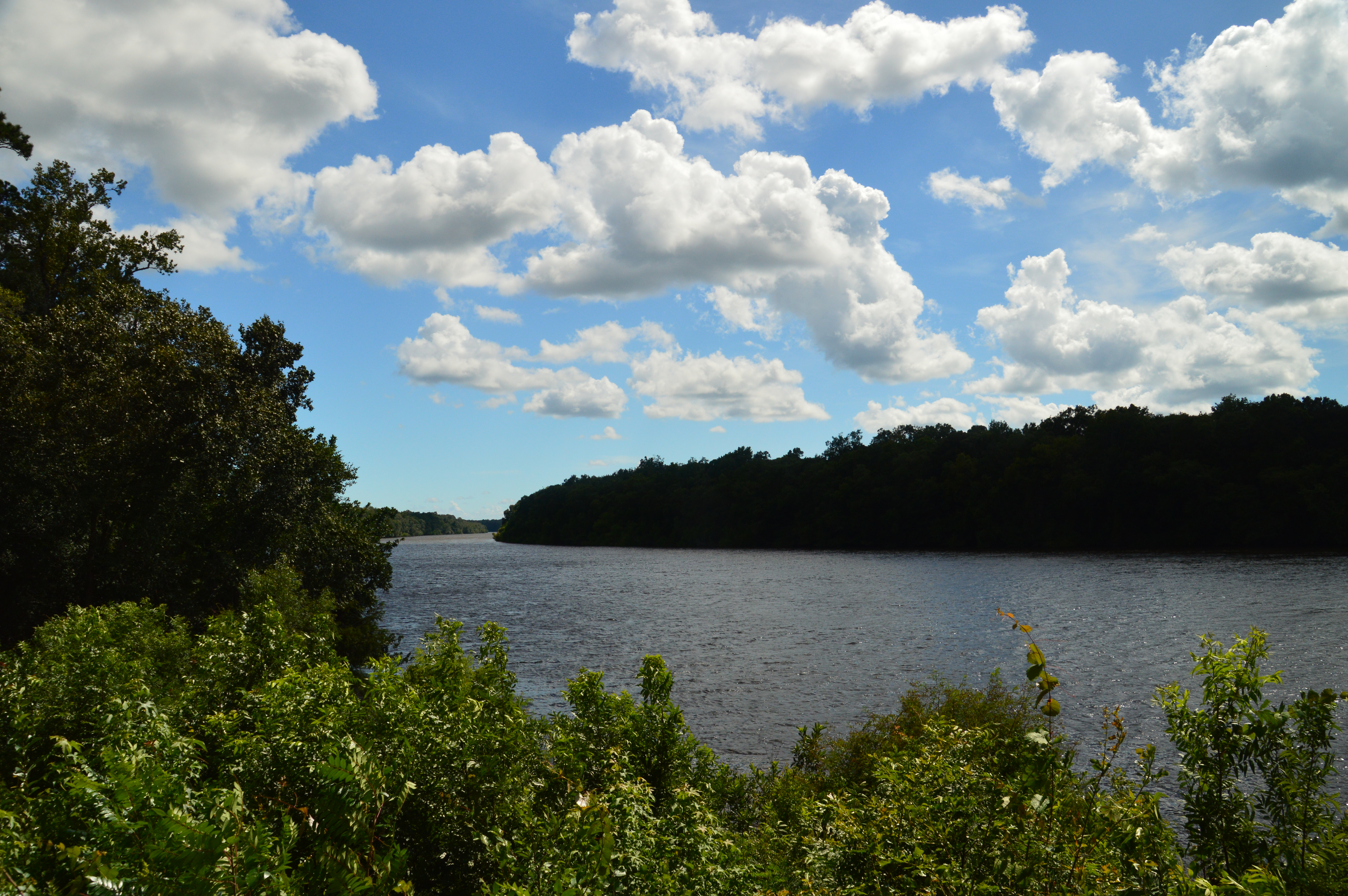
Prospect Bluff, located on the east side of the Apalachicola River deep in present-day Apalachicola National Forest, is the site of two forts, including Fort Gadsden, which had remained there until 1821, when Florida became a US territory. At the time, no highways or railroads existed, so the fort was located in a strategic spot at a high point near the Apalachicola River, which used to be the main transportation route for the area. Traces of the old fort can still be seen today on this short hike, and the Fort Gadsden Interpretive Area has detailed information regarding the history of this site. This hike occurred on Saturday, August 20th, 2016. My plan was to hike the Fort Gadsden Nature Trail counter-clockwise. This trail is also known as the Wiregrass-Genetian Trail, named for a rare wildflower that can be seen in the woods near Prospect Bluff.
Summary
R/T Length of Trail: 1.2 Miles
Duration of Hike: 0:50 Type of Hike: Loop Difficulty Rating: 1 out of 10 Total Elevation Gain: Minimal Pros: Easy nature trail with many points of interest that can be seen by everyone Cons: None Points of Interest: Site of Fort Gadsden (as well as some ruins); Views of Apalachicola River; Renegade Cemetery Trail Blaze Color(s): None Best Season(s) to Hike: Year-round Fees: None Beginning Point: Fort Gadsden Trailhead (or Prospect Bluff Historic Site Entrance Gate, if the site is closed) Directions from Sumatra, FL: From the intersection of FL State Route 65 and County Road 22 in Sumatra, follow Route 65 South for 4.0 miles. Then, turn right onto Fort Gadsden Road, also known as FS Road 129, which is an unpaved forest service road. It is in good shape and can be driven by all passenger vehicles, however. Follow this road for 2.1 miles, and then, turn left at a sign for Fort Gadsden onto FS Road 129B, and continue for 0.7 miles until you reach the entrance gate for the historic site. Map
Click here for more information and to download this trail map to view in Garmin Basecamp.
Details
The historic site at Prospect Bluff on the east side of the Apalachicola River is the site of two old forts from the 19th century. Prior to completing this short hike, my plan was to explore the historic site and see what I would find. As I arrived at the entrance to the historic site, I was greeted by a closed gate. As I have since learned, Prospect Bluff Historic Site was and still is closed due to the lack of an on-site host. However, there is a small unofficial parking area near the gate, so one could still head out on foot from here and explore the historic site (the walk is not long at all). The mileage in this trail report includes the walk from the gate.
From the gate, follow the forest road into the historic site. At 0.1 miles, note an unmarked path that comes out from the left. This is the end of the Fort Gadsden Nature Trail (which is also known as the Wiregrass-Genetian Trail), and you will finish the loop here. For now, continue on the forest road to its end at the official parking area and trailhead at 0.3 miles. Before you continue onto the nature trail, check out the exhibit regarding the forts that used to be here. Beyond the exhibit, a path to the right leads to a through-the-trees view of the Apalachicola River. Continue straight on the main trail to the site of the fort. At 0.5 miles, reach the edge of a large clearing that marks the site of Fort Gadsden. There isn't much left from the fort, but you can see some of the earthworks around the site. Notice the remains of old steamships lying in the shade to the right. Before highways and railroads were constructed, steamships were essential to transportation, and the Apalachicola River was the main transportation route. From the remains, walk up to the flag near the Apalachicola River for a grand view of the river, which is quite wide at this point. There is also a sketch here that shows how Fort Gadsden used to look like.
The first fort at the Prospect Bluff site was destroyed in 1816. The fort had been considered a danger to ships that traveled along the Apalachicola River, and as a result, the United States ordered for the fort to be destroyed. It was destroyed via a shot that landed right in the powder magazine of the fort, causing an explosion that also claimed the lives of nearly three hundred people, in addition to the fort. The second fort at Prospect Bluff was constructed when Andrew Jackson led a force to destroy Seminole villages in the area during the First Seminole War. Jackson liked the location of the first fort, so he ordered the construction of a supply base at the same spot. This construction was built by Lieutenant James Gadsden, after whom Fort Gadsden was named. Gadsden maintained the fort until 1821, when Spain let the United States take control of Florida. After this, the fort was not used for a long time. In the years of 1862 and 1863, Confederate troops occupied the fort, but they had to abandon it in July of 1863 as a result of malaria in the lowlands along the Apalachicola River.
After you have observed the site of Fort Gadsden and its perfect location at the Apalachicola River, cross the clearing and join the nature trail at the east end of the clearing. Cross a boggy area in the pine flatwoods using a pair of footbridges, and arrive at the site of the Renegade Cemetery at 0.9 miles. This is something that I am still a little bit confused about. I had read that there is an actual cemetery here, where the people who died in the explosion at the first fort are buried. However, I did not find a cemetery. I only found one heavily-overgrown grave. Thus, I am unsure of what happened to the cemetery. From the grave, continue on the nature trail northward through pine flatwoods. On this beautiful August day, there were plenty of flowers and blooming plants alongside the trail here. At 1.1 miles, reach the end of the trail at the forest road. Here, simply turn right onto the forest road to return to the gate and your car, concluding the hike at 1.2 miles. Mileage
0.0 - Prospect Bluff Historic Site Gate
0.3 - Fort Gadsden Trailhead 0.5-0.6 - Fort Gadsden site and views of Apalachicola River 0.9 - Renegade Cemetery 1.1 - End of nature trail 1.2 - Prospect Bluff Historic Site Gate Variations
There are no sensible variations for this hike. However, keep in mind that the hike will be 1.0 miles long if the gate to the historic site is actually open.
Bonus Stops
A picturesque hiking trail also near Sumatra is the Wright Lake Loop Trail. This 4.5-mile loop features the pine flatwoods typical to Apalachicola National Forest, as well as a couple of streams and Wright Lake itself. In late December 2015, I hiked a portion of this loop, but I was unable to complete the full loop due to flooding.
PicturesVideos
0 Comments
Leave a Reply. |
About MeMark Oleg Ozboyd Dear readers: I have invested a tremendous amount of time and effort in this website and the Georgia Waterfalls Database the past five years. All of the work that has gone in keeping these websites updated with my latest trip reports has almost been like a full-time job. This has not allowed me to pick up a paid job to save up money for college, and therefore, I I've had to take out loans. If you find the information on this website interesting, helpful, or time-saving, you can say "thanks" and help me out by clicking the button above and making a contribution. I will be very grateful for any amount of support you give, as all of it will apply toward my college tuition. Thank you!
Coming in 2022-2023?
Other Hiking WebsitesMiles HikedYear 1: 540.0 Miles
Year 2: 552.3 Miles Year 3: 518.4 Miles Year 4: 482.4 Miles Year 5: 259.9 Miles Archives
March 2021
Categories
All
|





















 RSS Feed
RSS Feed